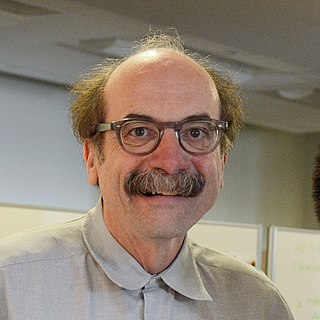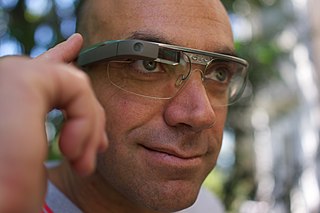
Augmented reality (AR) is an interactive experience that combines the real world and computer-generated content. The content can span multiple sensory modalities, including visual, auditory, haptic, somatosensory and olfactory. AR can be defined as a system that incorporates three basic features: a combination of real and virtual worlds, real-time interaction, and accurate 3D registration of virtual and real objects. The overlaid sensory information can be constructive, or destructive. This experience is seamlessly interwoven with the physical world such that it is perceived as an immersive aspect of the real environment. In this way, augmented reality alters one's ongoing perception of a real-world environment, whereas virtual reality completely replaces the user's real-world environment with a simulated one.
IDEO is a design and consulting firm with offices in the U.S., England, and China. It was founded in Palo Alto, California, in 1991. The company's 500 staff uses a design thinking approach to design products, services, environments, brands, and digital experiences.
Bose Corporation is an American manufacturing company that predominantly sells audio equipment. The company was established by Amar Bose in 1964 and is based in Framingham, Massachusetts. It is best known for its home audio systems and speakers, noise cancelling headphones, professional audio products and vehicle sound systems. Bose has a reputation for being particularly protective of its patents, trademarks, and brands.

Ambient devices are a type of consumer electronics, characterized by their ability to be perceived at-a-glance, also known as "glanceable". Ambient devices use pre-attentive processing to display information and are aimed at minimizing mental effort. Associated fields include ubiquitous computing and calm technology. The concept is closely related to the Internet of Things.
SteelcaseInc. is an international manufacturer of furniture, casegoods, seating, and storage and partitioning systems for offices, hospitals, classrooms, and residential interiors. It is headquartered in Grand Rapids, Michigan, United States.

Physical computing involves interactive systems that can sense and respond to the world around them. While this definition is broad enough to encompass systems such as smart automotive traffic control systems or factory automation processes, it is not commonly used to describe them. In a broader sense, physical computing is a creative framework for understanding human beings' relationship to the digital world. In practical use, the term most often describes handmade art, design or DIY hobby projects that use sensors and microcontrollers to translate analog input to a software system, and/or control electro-mechanical devices such as motors, servos, lighting or other hardware.

In computing, multi-touch is technology that enables a surface to recognize the presence of more than one point of contact with the surface at the same time. The origins of multitouch began at CERN, MIT, University of Toronto, Carnegie Mellon University and Bell Labs in the 1970s. CERN started using multi-touch screens as early as 1976 for the controls of the Super Proton Synchrotron. Capacitive multi-touch displays were popularized by Apple's iPhone in 2007. Multi-touch may be used to implement additional functionality, such as pinch to zoom or to activate certain subroutines attached to predefined gestures using gesture recognition.
Proteon Therapeutics, Inc. is a developer of pharmaceuticals with offices in Waltham, Massachusetts and Kansas City, Missouri.
The idea of technology brokering is to span multiple industries, and to see how existing technologies could be used to create breakthrough innovations in other markets. Technology brokering requires companies to be strong in two areas. As Andrew Hargadon, technology brokering's founder, summarized: "Firstly, the company must have the ability to bridge distant communities, usually when a company can move easily across a range of different markets they have a better view of how technologies can be used in new ways. Secondly, technology brokering involves creating new markets and industries from innovative combinations of existing technology. These two strengths are difficult to have simultaneously because the strong ties the companies have with customers and supplies in one industry prevent the company from moving easily into other markets and experimenting with new ideas."

David M. Kelley is an American engineer, designer, businessman, and educator. He is co-founder of the design firm IDEO and a professor at Stanford University. He has received several honors for his contributions to design and design education.

X Development LLC, doing business as X, is an American semi-secret research and development facility and organization founded by Google in January 2010. X has its headquarters about a mile and a half from Alphabet's corporate headquarters, the Googleplex, in Mountain View, California.

Zugara is an American corporation headquartered in Los Angeles, California, United States that develops and licenses augmented reality software and creates Natural User Interface experiences for brands.

NuoDB is a cloud-native distributed SQL database company based in Cambridge, Massachusetts. Founded in 2008 and incorporated in 2010, NuoDB technology has been used by Dassault Systèmes, as well as FinTech and financial industry entities including UAE Exchange, Temenos, and Santander Bank.

An optical head-mounted display (OHMD) is a wearable device that has the capability of reflecting projected images as well as allowing the user to see through it. In some cases, this may qualify as augmented reality (AR) technology. OHMD technology has existed since 1997 in various forms, but despite a number of attempts from industry, has yet to have had major commercial success.

zSpace is a technology firm based in San Jose, California that combines elements of virtual and augmented reality in a computer. zSpace mostly provides AR/VR technology to the education market. It allows teachers and learners to interact with simulated objects in virtual environments.

Smartglasses or smart glasses are eye or head-worn wearable computers that offer useful capabilities to the user. Many smartglasses include displays that add information alongside or to what the wearer sees. Alternatively, smartglasses are sometimes defined as glasses that are able to change their optical properties, such as smart sunglasses that are programmed to change tint by electronic means. Alternatively, smartglasses are sometimes defined as glasses that include headphone functionality.

Magic Leap, Inc. is an American technology company that released a head-mounted augmented reality display, called Magic Leap One, which superimposes 3D computer-generated imagery over real world objects. It is attempting to construct a light-field chip using silicon photonics.

Jocelyn Scheirer is an American entrepreneur, scientist, and artist who has been working in wearable technology since the late 1990s. Her research focuses on Affective Computing, which she pursued while pursuing her PhD (pending) at MIT Media's Lab Affective Computing Group with Rosalind Picard. Scheirer invented and, along with MIT, patented the Galvactivator glove which measured skin conductance through sensors on the palm and relayed the varying intensity through an LED display. She founded the intercommunication equipment and systems company Empathyx, Inc. in 2006 and co-founded the emotional analytics company Affectiva in 2009, serving as their director of operations until 2010. Scheirer has also created several visual and performance art pieces that have been featured in several galleries in Massachusetts including the MIT Museum, the Galatea Fine Art Gallery, and the Bromfield Gallery. She currently serves as CEO of the wearable company Bionolux Labs, LLC.
Flavia Sparacino is an American-based space maker and scientist. She is currently CEO/Founder of Sensing Places, a MIT Media Lab spinoff that specializes in immersive space design and technology.
Fyuse is a spatial photography app which lets users capture and share interactive 3D images. By tilting or swiping one's smartphone, one can view such "fyuses" from various angles — as if one were walking around an object or subject.












